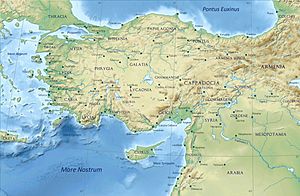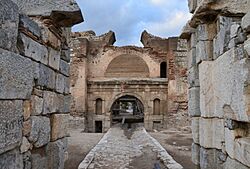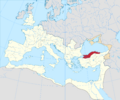Bithynia facts for kids
Quick facts for kids Bithynia (Βιθυνία) |
|
|---|---|
| Ancient Region of Anatolia | |

Bithynia and Pontus as a province of the Roman Empire, 125 AD
|
|
| Location | Northern Anatolia, present-day Turkey |
| State existed | 297–74 BC |
| Nation | Greeks, Bithyni, Thyni |
| Historical capitals | Nicomedia (İzmit), Nicaea (İznik) |
| Roman province | Bithynia |
Bithynia (Koinē Greek: Βιθυνία, romanized: Bithynía) was an ancient land in the northwest of what is now Turkey. It was a powerful kingdom and later a Roman province. Bithynia was located next to the Sea of Marmara, the Bosporus strait, and the Black Sea.
It shared borders with Mysia to the southwest and Paphlagonia to the northeast. To the southeast, it bordered Phrygia. The independent Kingdom of Bithynia began around the 4th century BC. Its capital city, Nicomedia, was rebuilt in 264 BC by King Nicomedes I of Bithynia.
In 74 BC, Bithynia was given to the Roman Republic. It then joined with the Pontus region to form the Roman province of Bithynia and Pontus. Later, in the 7th century, it became part of the Byzantine Opsikion theme. In the 13th century, it became a border area with the Seljuk Empire. Finally, the Ottoman Turks conquered Bithynia between 1325 and 1333.
Contents
What was Bithynia Like?
Bithynia had several important cities along the fertile shores of the Propontis, now known as the Sea of Marmara. These cities included Nicomedia, Chalcedon, Cius, and Apamea. Bithynia was also home to Nicaea, famous as the birthplace of the Nicene Creed. This was an important statement of Christian beliefs.
The land of Bithynia was full of mountains and forests. But it also had very fertile valleys and coastal areas. The most important mountain range was the "Mysian" Olympus, now called Uludağ. It is about 8,000 feet (2,400 meters) tall. This mountain stands high above the city of Bursa. You can even see it from Istanbul, which is about 70 miles (110 km) away. Its peaks are covered with snow for most of the year.
East of this mountain, the range stretches for more than 100 miles (160 km). It goes from the Sakarya to Paphlagonia. These mountains form part of the border of the large plateau of Anatolia, in Turkey. The western coast of Bithynia had two deep inlets. The Gulf of İzmit reached far inland, almost to the Black Sea. The Gulf of Mudanya was about 25 miles (40 km) long.
Rivers and Resources
The main rivers in Bithynia were the Sangarios, which flowed from south to north. The Rhyndacus river separated Bithynia from Mysia. The Billaeus (Filyos) river started in the Aladağ mountains. It flowed past modern Bolu and into the Black Sea. The Parthenius river marked the eastern border of the province.
The valleys near the Black Sea were rich in fruit trees, like oranges. The Sangarius valley and the plains near Bursa and Iznik (Nicaea) were very fertile. They were well-farmed. Many mulberry trees grew there. These trees provided silk, for which Bursa was famous. Silk was produced there on a large scale.
A Look at Bithynia's History
Early History and Thracian Tribes
Bithynia got its name from the Bithyni tribe. This was a Thracian tribe. The historian Herodotus mentioned them along with the Thyni tribe. These tribes likely moved from the Balkans to Asia Minor after the Bronze Age collapse. The Thyni and Bithyni settled side by side. They either pushed out or took over other smaller tribes in the area.
Later, the Greeks built colonies on the coast. These included Cius (modern Gemlik), Chalcedon (modern Kadıköy), and Heraclea Pontica (modern Karadeniz Ereğli). The Bithynians were later taken over by King Croesus of Lydia. Then, in 546 BC, they came under the rule of the Persian Empire. They became part of the satrapy (a type of province) of Phrygia.
The Kingdom of Bithynia
Even before Alexander the Great conquered many lands, the Bithynians fought for their freedom. They kept their independence under two local princes, Bas and Zipoites. Zipoites even took the title of king in 297 BC.
His son, Nicomedes I, founded the city of Nicomedia. This city quickly became very successful. During his long rule (around 278–255 BC) and the reigns of later kings like Prusias I and Nicomedes II, the kings of Bithynia were important and influential among the smaller kingdoms of Anatolia.
However, the last king, Nicomedes IV, could not hold onto power against Mithridates VI of Pontus. After the Roman Senate helped him get his throne back, he decided to give his kingdom to the Roman Republic in his will. This happened in 74 BC. The coins from these kings show their royal portraits. These portraits were made in a very skilled Hellenistic style.
Bithynia as a Roman Province
When Bithynia became a Roman province, its borders often changed. During this time, Bithynia was usually joined with the province of Pontus for administrative reasons. This was the case when Emperor Trajan ruled. Pliny the Younger was the governor of both provinces from 109/110 to 111/112 AD. His letters give historians valuable information about how the Romans managed their provinces.
Bithynia in the Byzantine Empire
Under the Byzantine Empire, Bithynia was again split into two provinces. The Sangarius river separated them. Only the area west of the river kept the name Bithynia.
Bithynia was very important because of its roads and its key location. It was between the frontiers of the Danube in the north and the Euphrates in the southeast. To keep communication open with the eastern provinces, a huge bridge across the Sangarius river was built around 562 AD. Roman troops often spent the winter in Nicomedia.
During this period, the most important cities in Bithynia were Nicomedia and Nicaea. These two cities had a long rivalry. They often argued about which city should be the capital.
Famous People from Bithynia
Many notable people came from Bithynia:
- Hipparchus of Nicaea (2nd century BC): A Greek astronomer. He discovered how planets move and how to predict eclipses.
- Theodosius of Bithynia (2nd century BC): A Greek astronomer and mathematician.
- Asclepiades of Bithynia (around 169–100 BC): A Greek doctor.
- Cassius Dio (around 155–235 AD): A Roman historian, senator, and consul.
- Arrian (Lucius Flavius Arrianus) (around 86–160 AD): A Greek historian.
- Helena (around 250–330 AD): The mother of Constantine the Great, a famous Roman Emperor.
- Phrynichus Arabius (2nd century): A grammarian, someone who studies language rules.
- Auxentius of Bithynia (around 400–473 AD): A hermit, someone who lives alone for religious reasons.
- Hypatius of Bithynia (died around 450 AD): Another hermit.
- Vendemianus of Bithynia (6th century): Also a hermit.
Images for kids
See also
 In Spanish: Bitinia para niños
In Spanish: Bitinia para niños
- Bithynian coinage
- Ancient regions of Anatolia








